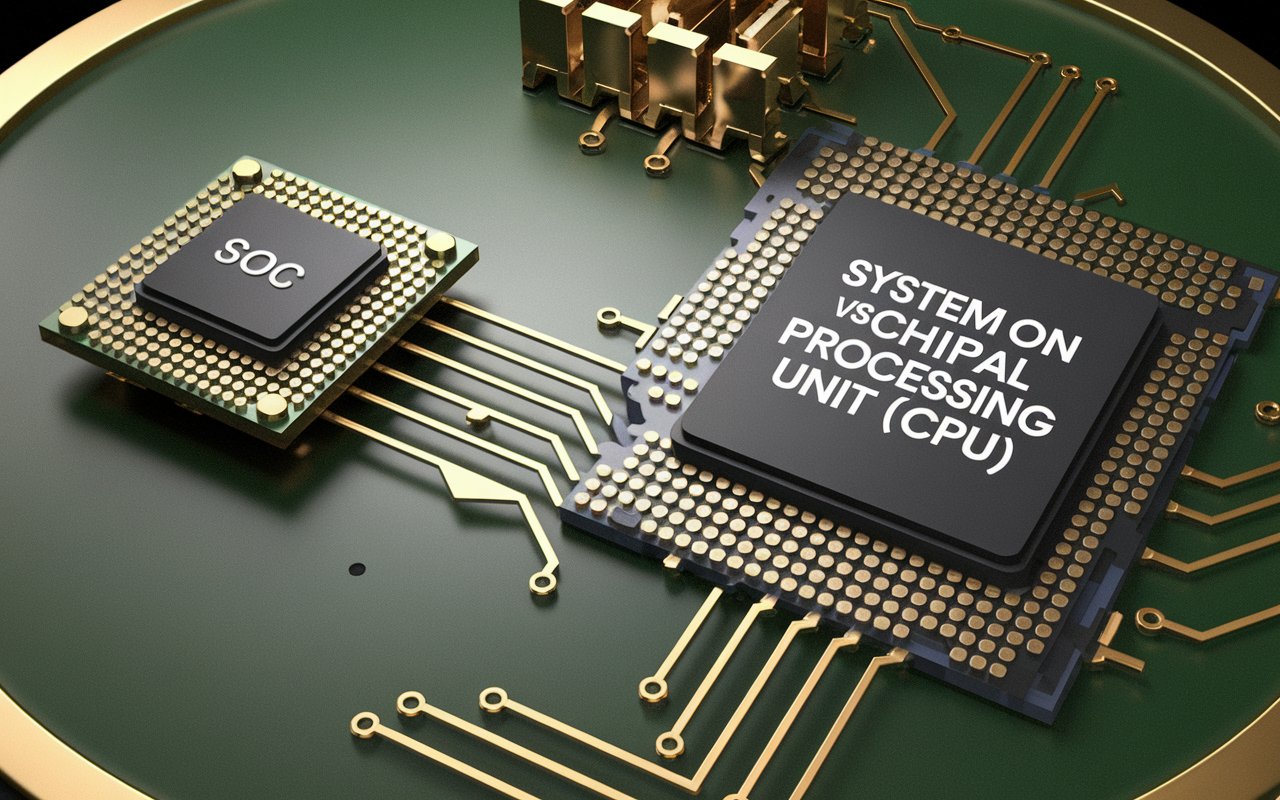
In today’s technology-driven world, understanding the difference between a System on Chip (SoC) and a Central Processing Unit (CPU) is crucial.
Both play key roles in powering modern devices, but they are designed for different purposes. CPUs are typically found in desktops and laptops, handling high-performance tasks, while SoCs integrate multiple components like the CPU, GPU, and memory into a single chip, making them ideal for mobile devices.
With advancements in efficiency and integration, SoCs are becoming more common in a wide range of applications. This article explores the key distinctions between SoC and CPU, their use cases, and future trends.
What is a CPU and what role does it play in a computer system?
A CPU (Central Processing Unit) is the primary component of a computer that processes instructions from programs and performs calculations.
It acts as the brain of the system, managing tasks like arithmetic, logic, and input/output operations. The CPU ensures that all other hardware components work together efficiently.
Why does CPUs excel in high-performance computing environments?
CPUs excel in high-performance computing environments due to their ability to handle complex tasks with high clock speeds and advanced caching mechanisms, which minimize data retrieval times.
Their multiple cores enable efficient parallel processing, allowing for better multitasking and workload management.
Additionally, support for specialized instruction sets enhances their capability to execute demanding applications, making them ideal for data-intensive tasks.
What is an SoC and how is it different from a CPU?
An SoC (System on Chip) is an integrated circuit that combines a CPU, GPU, memory, and other components onto a single chip, designed for efficiency and compactness.
Unlike a standalone CPU, which only handles processing tasks, an SoC integrates multiple functions, making it ideal for mobile devices and embedded systems.
What are the advantages of using an SoC compared to a CPU?
An SoC offers advantages like greater power efficiency, reduced space, and lower costs due to its integrated design, making it ideal for mobile and compact devices.
It also improves performance by reducing communication delays between components, unlike a standalone CPU that requires separate chips for additional functions.
In what applications are SoCs typically used, and why?
SoCs are typically used in smartphones, tablets, wearables, and IoT devices because of their compact size, energy efficiency, and ability to integrate multiple functions on a single chip. This makes them ideal for space-constrained and battery-powered applications.
Do laptops use SoCs?
Yes, some laptops, especially those using ARM-based chips, now use SoCs for better power efficiency and longer battery life.
These SoC-powered laptops are designed to offer a balance between performance and portability, similar to mobile devices.
What devices use SoC?
SoCs are commonly used in smartphones, tablets, smartwatches, and various IoT devices due to their compact design and energy efficiency.
They can also be found in embedded systems, smart home devices, and some laptops, providing an all-in-one solution for various applications.
Which SoC is best for gaming?
The Qualcomm Snapdragon 8 Gen 2 and Apple’s A17 Pro are among the best SoCs for gaming, offering high performance with advanced graphics processing and energy efficiency. These SoCs are commonly used in premium smartphones and tablets designed for gaming.
Is a SoC a microcontroller or microprocessor?
A SoC is neither strictly a microcontroller nor a microprocessor, but it can contain both. It integrates a microprocessor (like a CPU) along with other components, whereas a microcontroller is a simpler, more focused system often used in specific control tasks.
Is SoC better than CPU?
Whether a SoC is better than a CPU depends on the application; SoCs excel in energy efficiency and compactness for mobile devices, while CPUs offer superior performance for demanding tasks in desktops and servers. Thus, the choice between them hinges on specific use cases and performance requirements.
Why is putting two kinds of CPU in a SoC useful?
Integrating two types of CPUs, such as a high-performance core and a power-efficient core, in an SoC allows for optimized performance and energy management.
This configuration, often referred to as big.LITTLE architecture, enables devices to handle demanding tasks efficiently while conserving battery life during lighter workloads.
What is hybrid systems?
Hybrid systems refer to computing architectures that combine different types of processors or processing cores, such as traditional CPUs and SoCs, to optimize performance and energy efficiency.
This approach allows devices to dynamically allocate tasks to the most suitable processor, enhancing multitasking and reducing power consumption.
Are there any hybrid systems that use both SoCs and CPUs together?
Yes, hybrid systems can utilize both SoCs and traditional CPUs, particularly in devices like laptops and tablets where performance and efficiency are required.
This combination allows the device to leverage the strengths of both architectures, offering powerful processing capabilities alongside energy-efficient operation for everyday tasks.
Is Soc different from the processor?
Yes, an SoC (System on Chip) is different from a traditional processor; it integrates multiple components, including a CPU, GPU, memory, and peripherals, onto a single chip.
In contrast, a traditional processor typically refers to just the CPU, which focuses solely on executing instructions and performing calculations.
What is the advantage of dual-core processors?
The advantage of dual-core processors lies in their ability to execute multiple tasks simultaneously, improving multitasking performance and overall system responsiveness.
This parallel processing capability allows for better handling of demanding applications and smoother operation in a variety of computing environments.
What is the future of SoCs and CPUs in computing?
The future of SoCs and CPUs in computing is expected to see increasing integration, with SoCs becoming more prevalent in laptops and desktops for enhanced power efficiency and portability.
Meanwhile, CPUs will continue to evolve, focusing on higher performance and specialized processing capabilities, particularly for artificial intelligence and high-performance computing tasks.
FAQS
1. Are SoC and CPU the same?
No, SoCs (System on Chips) and CPUs (Central Processing Units) are not the same; an SoC integrates a CPU along with other components like a GPU and memory into a single chip, while a CPU is solely responsible for processing tasks.
2. Why are SoCs commonly used in smartphones and tablets?
SoCs are highly integrated, compact, and energy-efficient, making them ideal for mobile devices where space and battery life are critical.
3. Can an SoC replace a traditional CPU in high-performance tasks?
While SoCs are excellent for mobile and low-power applications, traditional CPUs are generally more powerful and better suited for high-performance tasks like gaming, video editing, and server operations.
4. Which is more power-efficient, an SoC or a CPU?
SoCs are generally more power-efficient because they integrate multiple components on a single chip, reducing the need for separate power supplies for each component.
5. Are SoCs only used in mobile devices?
No, SoCs are also used in embedded systems, smart home devices, wearables, and even some computers, especially in cases where space, cost, and power efficiency are priorities.
6. What does it mean when a laptop uses an ARM-based SoC?
ARM-based SoCs are common in mobile devices, and some laptops are adopting them for better power efficiency and longer battery life. These chips typically emphasize efficiency over raw performance.
8. Can a CPU be part of an SoC?
Yes, in fact, an SoC always includes a CPU as one of its core components, but it also includes other elements like memory, graphics processors, and communication interfaces.
9. How do SoCs handle graphics processing compared to CPUs?
SoCs often include a built-in GPU (Graphics Processing Unit), which is designed to handle graphic-intensive tasks, whereas CPUs typically require separate graphics cards or chips for high-end graphics processing.
Conclusion
While SoCs and CPUs serve distinct roles in modern computing, each brings unique advantages tailored to specific applications.
SoCs are ideal for energy-efficient, compact devices like smartphones and IoT gadgets, whereas CPUs excel in high-performance computing environments.
As technology continues to advance, the integration of both architectures will likely enhance device capabilities, making computing more versatile and efficient across a wide range of platforms.




